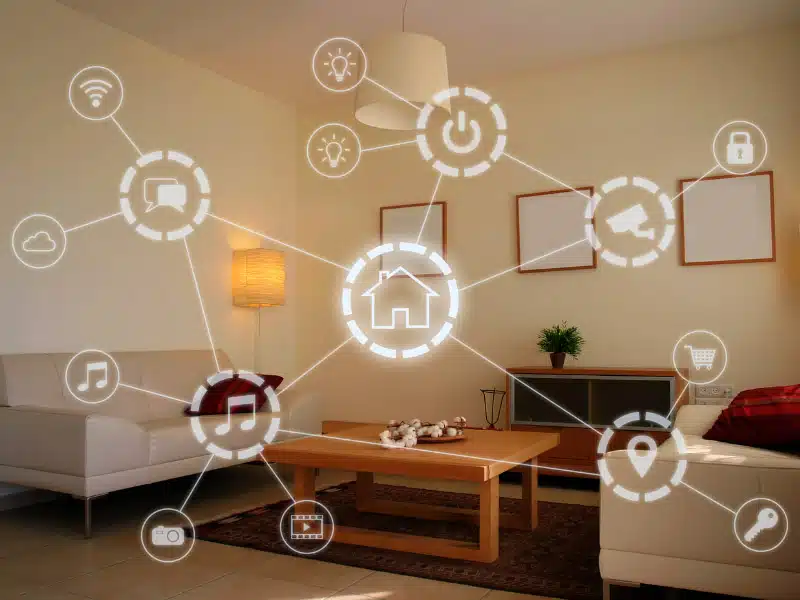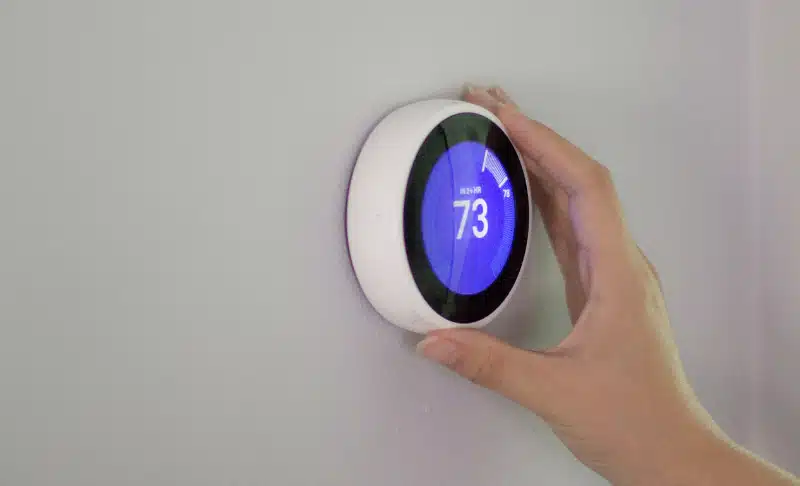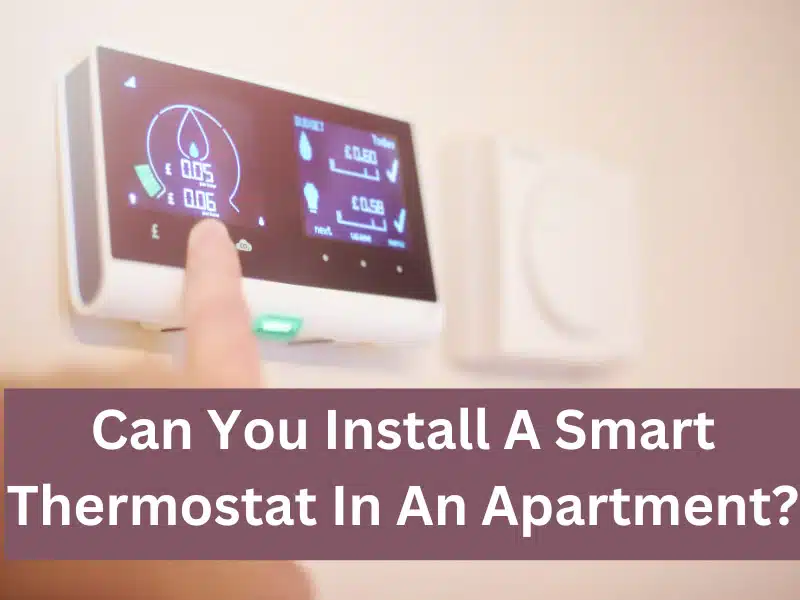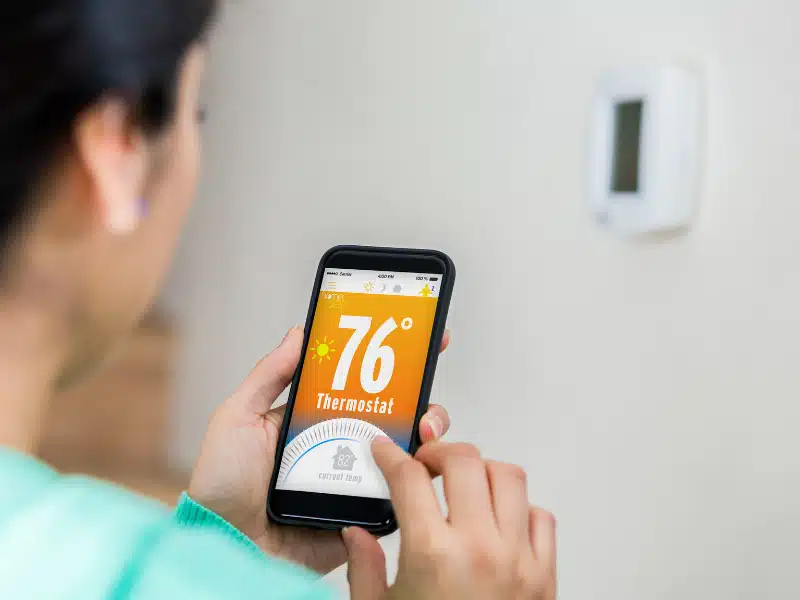With features like energy-saving settings, remote control via smartphone, and even learning your habits over time, it’s no surprise that more and more people are considering upgrading to a smart thermostat.
But what if you live in an apartment? Is it feasible, or even allowed, to install a smart thermostat?
The answer is” Maybe.”
We’re looking at potential challenges, key considerations, and offering you practical advice.
Whether you’re a renter curious about incorporating smart tech into your living space or a landlord keen on modernizing your rental units, this guide is for you.
Why Install a Smart Thermostat in an Apartment? (Benefits)

Lower Energy Bills
Installing a smart thermostat in your apartment can help you save money on energy costs.
By allowing you to set schedules and customize temperature settings, you can optimize your heating and cooling system for maximum efficiency.
This can lead to lower energy bills, giving you more financial freedom in the long run.
Increase Comfort
A smart thermostat can increase the comfort level in your apartment by maintaining a consistent temperature based on your preferences.
You can set different temperatures for different times of the day or adjust settings remotely to ensure your home is always at the ideal temperature when you return.
Convenience and Control
With a smart thermostat, you’ll enjoy the convenience of controlling your home’s temperature from anywhere using your smartphone.
Whether you’re in bed or away from your apartment, you can change the temperature, set schedules, and monitor your HVAC system with just a few taps on your phone.
Voice-Assistant Compatibility
Many smart thermostats are compatible with voice assistants like Amazon Alexa, Google Assistant, and Apple’s Siri.
This allows you to control your thermostat using voice commands, making temperature adjustments as simple as asking for it.
By integrating a smart thermostat with a voice assistant, you can create a more cohesive and efficient smart home experience.
Types of Smart Thermostats
When you’re considering installing a smart thermostat in your apartment, it’s important to know about the different types available on the market.
In this section, we’ll discuss Nest Thermostats, Ecobee Thermostats, Honeywell Thermostats, and Google Nest Thermostats.

Nest Thermostats
Nest offers a variety of smart thermostats, the most popular being the Nest Learning Thermostat.
This device learns your heating and cooling preferences over time, which allows it to automatically adjust the temperature based on your habits.
You can also control it remotely through a smartphone app, and it is compatible with many voice-activated assistants like Google Assistant and Amazon Alexa.
Ecobee Thermostats
Ecobee has a range of smart thermostats, with the Ecobee4 and Ecobee SmartThermostat being amongst their most popular models.
These devices come with built-in Amazon Alexa voice control, and they also have remote sensors that help in delivering the desired temperature in specific rooms.
You can monitor and control your Ecobee thermostat through a smartphone app and integrate it with different smart home platforms, such as Apple HomeKit, Samsung SmartThings, and IFTTT.
Honeywell Thermostats
Honeywell is a well-established name in the thermostat industry, and their smart thermostats offer a variety of features.
The Honeywell Home T9 and T5 are popular models that provide energy-saving options, easy scheduling, and smart home integration.
These devices can be controlled through a smartphone app or even just by using voice commands with compatible smart home platforms.
Honeywell thermostats are also known for their compatibility with a wide variety of HVAC systems.
Google Nest Thermostats
The Google Nest Thermostat is the latest offering in the Nest lineup, designed as a more affordable and simplified version of the Nest Learning Thermostat.
This device still offers smart features like scheduling, energy-saving options, and remote control through a smartphone app or voice commands, but it lacks some of the more advanced learning and automation features of the Nest Learning Thermostat.
It is also compatible with major smart home platforms like Google Assistant and Amazon Alexa.
In summary, several types of smart thermostats cater to varying needs and budgets, each offering distinct features and benefits.
Make sure to research and compare the different options to find one that best suits your lifestyle and enhances your apartment living experience.
Compatibility and Installation

Compatibility with HVAC System
Before you try to install a smart thermostat in your apartment, it’s essential to make sure that your HVAC system is compatible.
Most smart thermostats, including the popular Nest, work with various heating and cooling systems, but there can still be some limitations.
Check the manufacturer’s compatibility guidelines and your apartment’s HVAC system to ensure seamless integration.
Wiring Considerations
When it comes to wiring, you’ll want to ensure that your apartment’s existing wiring can support the new smart thermostat.
Many smart thermostats require a common wire (c-wire) to supply continuous power for advanced features like Wi-Fi and touchscreen controls.
If your apartment lacks a c-wire, you have several options:
- Install a c-wire adaptor, which lets you use two existing wires as a c-wire.
- Use a power extender kit, available from thermostat manufacturers like Nest and Ecobee, designed to share power without a c-wire.
- Replace your existing thermostat wire with a new one that includes a c-wire.
Be cautious when working with wires, and if you’re unsure about any step, consult a professional electrician.
Power and Wi-Fi Requirements
Your smart thermostat will need a reliable Wi-Fi connection and power supply for optimal performance.
Check your apartment’s Wi-Fi signal strength near the thermostat location, and make sure that the smart thermostat you’re considering can connect to the existing network.
Some smart thermostats can be powered by batteries, while others require a connection to the HVAC system.
When selecting a thermostat, make sure it’s compatible with your apartment’s power sources and, if needed, has the necessary adaptors or power extension kits.
By taking these compatibility and installation factors into account, you can ensure a smooth transition to a smart thermostat in your apartment, making your living space more comfortable and energy-efficient.
Permission and Legal Considerations

Getting Landlord Approval
Before installing a smart thermostat in your rental apartment, it’s crucial to obtain approval from your landlord or property manager.
This is not only out of respect for their ownership but also to ensure you’re complying with the rental agreement.
Approach your landlord in a polite and professional manner, explaining the benefits of a smart thermostat, such as energy savings and convenience.
You might even propose to cover the installation costs yourself to increase the chances of approval.
Legal Issues for Renters
As a renter, it’s essential to consider any legal implications of installing a smart thermostat in your apartment.
While landlords can control the thermostat in most states, tenant rights regarding temperature control can vary.
To avoid potential legal disputes or violations of your rental agreement, thoroughly research your local laws and regulations before attempting any installation.
This includes checking for any restrictions on altering rental properties, such as restrictions on drilling holes for mounting the device.
By carefully considering these aspects, you can ensure a smooth and successful process in installing a smart thermostat in your apartment.
Remember to always communicate openly with your landlord or property manager and to follow the appropriate legal guidelines.
How to Install a Smart Thermostat
Step-by-Step Instructions
- Turn off the power to your old thermostat by switching off the circuit breaker for the heating and cooling system.
- Carefully remove your old thermostat to expose the wiring behind it. Label the wires according to their corresponding terminals to make the reconnection process easier.
- Unscrew and remove the backplate of your old thermostat. You should now see the wires that were connected to the terminals.
Handling Electrical Wiring
- Check the wiring and look for a common wire (C-Wire) which is usually colored blue or black. The C-Wire is necessary for the continuous power supply to your smart thermostat. If your old thermostat doesn’t have one, you may need to check the installation guide for workarounds or consider calling a professional to install one for you.
- Unscrew the terminals and gently pull out the wires to separate them. Make sure they won’t fall back into the wall; you can use tape to secure them in place.
Mounting the Smart Thermostat
- Position the backplate of your new smart thermostat onto the wall, making sure it’s level. Mark the screw holes with a pencil.
- Use a drill to create holes for the wall anchors, install the anchors, and attach the backplate with screws.
- Connect the wires to their corresponding terminals on the smart thermostat. Refer to the labels you made earlier as well as the installation guide for assistance.
- Attach the smart thermostat to the backplate and turn the power back on at the circuit breaker.
Professional Installation vs DIY
Weighing the Costs and Benefits
Considering installing a smart thermostat in your apartment?
It’s essential to weigh the costs and benefits of professional installation versus doing it yourself (DIY).
On one hand, hiring a professional electrician can ensure a hassle-free installation and might be required if your landlord insists on it.
On the other hand, going the DIY route can potentially save you money, but it also comes with the responsibility of dealing with any installation challenges.
When to Hire a Professional
You may want to consider hiring a professional electrician if:
- You don’t feel confident about working with electrical wiring.
- Your apartment has an older heating/cooling system that may need compatibility checks.
- Your landlord requires professional installation for any changes to the apartment’s systems.
Hiring a professional can ensure that your smart thermostat is installed correctly and safely, giving you peace of mind.
However, it might come at a higher cost compared to the DIY approach.
Tips for DIY Installation
If you decide to go ahead with the DIY installation, here are some tips to guide you through the process:
- Check compatibility with your HVAC system: Make sure that your smart thermostat is compatible with your apartment’s heating and cooling systems.
- Turn off the power: Before starting the installation, it’s crucial to turn off the power to your HVAC system at the main service panel.
- Keep track of wiring: Label the existing wiring on your old thermostat before disconnecting it. This will ensure you’re able to reconnect the wires properly on your new smart thermostat.
- Read the installation guide carefully: The smart thermostat should come with a detailed installation guide that you should carefully follow to make sure everything is functioning correctly.
- Test your smart thermostat: Once you’ve installed your new smart thermostat, test it to ensure that it’s operating properly and effectively controlling your apartment’s heating and cooling systems.
Remember, while DIY installation can save you money, it’s essential to proceed with caution, especially if you’re not experienced with electrical work.
Potential Technical Issues
Dealing with Circuit Breakers
When installing a smart thermostat in your apartment, one potential technical issue you may face is dealing with circuit breakers.
Before starting the installation process, it’s important to locate your apartment’s breaker panel and identify the appropriate circuit breaker for your heating and cooling system.
To ensure your safety, turn off the corresponding circuit breaker before working on your thermostat.
Keep in mind that older apartments may have outdated or hard-to-locate breaker panels, so you may need to consult your landlord or building maintenance personnel for assistance.
Security Vulnerabilities
Smart thermostats provide convenient control over your apartment’s temperature settings, but they can also introduce security risks.
Since these devices are connected to your home’s Wi-Fi network, they may be vulnerable to cyberattacks.
To minimize these risks, make sure to:
- Choose a smart thermostat with a strong reputation for security and reliable software updates.
- Keep your device firmware up to date by frequently checking for updates.
- Secure your home Wi-Fi network with a strong password and consider enabling additional security measures like two-factor authentication.
Warranty Coverage
Another potential concern when installing a smart thermostat in your apartment is warranty coverage.
If you’re replacing an existing thermostat, be aware that altering your heating and cooling system’s wiring could potentially void any existing warranties on your equipment.
Before starting the installation process, consult your system’s warranty information to understand what modifications are allowed.
If you’re unsure, it may be a good idea to consult a professional HVAC technician or your landlord for guidance.
Additionally, you gotta make sure to check the warranty coverage for your new smart thermostat itself, as this will provide you with peace of mind should any issues arise in the future.
Frequently Asked Questions
Do apartments allow smart thermostat installation?
It depends on the specific apartment and the agreement you have with your landlord.
Generally, it is a good idea to ask your landlord for permission before you go installing a smart thermostat in your rental property.
Some landlords may be open to the idea, especially if the device can lead to energy savings and potentially lower utility bills.
Keep in mind that you should be prepared to return the apartment to its original condition when you move out.
How do I install a Nest thermostat in a rental property?
First, obtain permission from your landlord.
Once that is settled, follow these steps to install a Nest thermostat:
- Turn off the power to your current thermostat and heating/cooling system.
- Remove the existing thermostat cover to expose the wiring.
- Take a picture of the wiring as a reference, then label the wires with the provided labels.
- Disconnect the wires and remove the old base plate.
- Install the Nest base plate using the provided screws. Make sure the built-in bubble level is centered for a proper installation.
- Connect the labeled wires to the corresponding terminals on the Nest thermostat base.
- Attach the display by pressing it firmly onto the base until it clicks in place.
- Turn the power back on and follow the setup instructions on the Nest display.
Remember that if you are not comfortable with this process, you can always hire a professional to install the thermostat for you.
Are there compatibility issues with smart thermostats in older apartments?
Compatibility may be an issue in some older apartments due to different types of heating systems or wiring configurations.
Before purchasing a smart thermostat, it’s essential to check that the device is compatible with your particular heating and cooling system.
Most smart thermostats, like Nest and Ecobee, provide compatibility check tools on their websites to help you determine if your system is a good fit.
What are the best smart thermostats for apartments?
Some of the best smart thermostats for apartments include:
- Nest Learning Thermostat: This device offers a sleek design, learns your preferred schedule, and optimizes energy savings. It pairs well with other Google Home devices, too.
- Ecobee3 Lite or Ecobee4: Both models offer energy-saving features and compatibility with external room sensors to balance temperatures throughout your space. The Ecobee4 also has built-in Amazon Alexa voice control.
- Honeywell Home T9: This smart thermostat features an intuitive interface, a clear display, and room sensor capability for a highly personalized comfort experience.
Make sure to check compatibility with your apartment’s system and confirm with your landlord before purchasing any smart thermostat.
